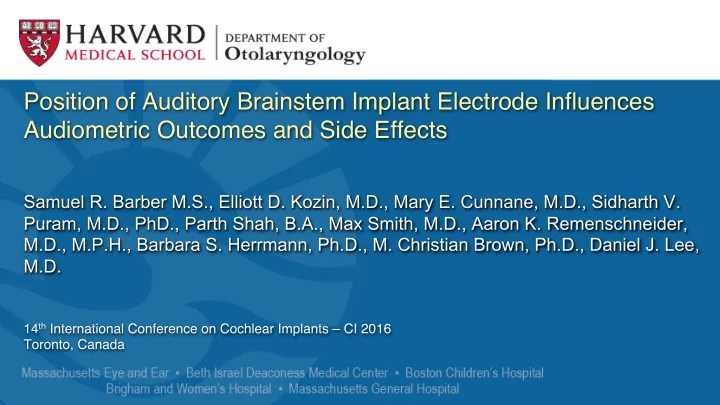

Position of Auditory Brainstem Implant Electrode Influences Audiometric Outcomes and Side Effects Samuel R. Barber M.S., Elliott D. Kozin, M.D., Mary E. Cunnane, M.D., Sidharth V. Puram, M.D., PhD., Parth Shah, B.A., Max Smith, M.D., Aaron K. Remenschneider, M.D., M.P.H., Barbara S. Herrmann, Ph.D., M. Christian Brown, Ph.D., Daniel J. Lee, M.D. 14 th International Conference on Cochlear Implants – CI 2016 Toronto, Canada Massachusetts Eye and Ear Infirmary Harvard Medical School
No disclosures or conflicts of interest Massachusetts Eye and Ear Infirmary Harvard Medical School
1 Background Auditory Brainstem Implant placement - ABI’s are placed directly over the brainstem in proximity to the dorsal cochlear nucleus (DCN) - Placement is “blind” and electrophysiology is utilized to confirm placement - Audiometric outcomes vary widely among similar cohorts - Electrodes are commonly inactivated due to side effects Massachusetts Eye and Ear Infirmary Harvard Medical School
� � � 1 Rationale Artifact obscures electrode position in post-op CT MPR View: Electrode positioning is Nucleus Profile ABI Standard Axial View: impossible to determine � 541 with flexible windmill streak artifact array (Cochlear) present � (NOT FDA APPROVED) � � � Massachusetts Eye and Ear Infirmary Harvard Medical School
1 Hypothesis ABI electrode array position can be resolved We hypothesize that: 1) Post-operative Computed Tomography (CT) can resolve electrode array position in 3D space. 2) CT determined ABI array positions correlate with audiometric data and side effects. Massachusetts Eye and Ear Infirmary Harvard Medical School
2 Methods Methods 3D Reconstruction of Post-operative CT Proximal Electrode Tip Basion • 4 Pediatric (non-NF2) and 7 Adult ABI subjects (6 NF2, 1 non-NF2) from our institution • (IRB approved protocols #340312, #441528, #444277). POSTER 101 SESSION B • True axial series were reformatted in Multiplanar Reconstruction (MPR) using the McRae line. DICOM files were imported into Osirix MD v.7.0.1 64-bit. Basion and electrode tip coordinates were marked in MPR Massachusetts Eye and Ear Infirmary • CT series were then viewed in 3D Maximum Intensity Projection (MIP) Harvard Medical School
2 Methods 3D Maximum Intensity Projection 360 o view of post-operative axial CT scan Massachusetts Eye and Ear Infirmary Harvard Medical School
2 Methods 3D Reconstruction of Post-operative CT • 3D maximum intensity projection (MIP) revealed electrode array position • Linear and angular measurements between marked coordinates were made Massachusetts Eye and Ear Infirmary using standard posterior and lateral views Harvard Medical School
2 Methods A new classification system for electrode positions Massachusetts Eye and Ear Infirmary Harvard Medical School
2 Methods Audiometric Analysis Post-activation data included: • The number and distribution of active electrodes and side effects • Psychophysical threshold (T) levels during perceptual testing Massachusetts Eye and Ear Infirmary Harvard Medical School
3 Results A wide variety of angles were observed • All arrays were normalized to the right side for comparison • the majority of electrodes have a range of angles between 0-90 degrees with respect to the horizontal. Massachusetts Eye and Ear Infirmary Harvard Medical School
3 Results Subject Responses: T Values, disabled electrodes (X) 4 Pediatric Subjects Subject T Values (2 revisions) 6 Adult Subjects (All displayed as if R side) Subject T Values Posterior view Massachusetts Eye and Ear Infirmary Harvard Medical School
3 Results Some orientations may be more optimal than others Combined Classification Types in Subjects with Audiometric Data Combined n (Adult, Mean number of Mean number of Mean T’s during ABI Classification Pediatric) active electrodes (n) side effects (n) programming (n) Type IA (1, 1) 12 (2) 2.5 (2) 98.4 CL (2) 3 (1) 135.29 CL (1) Type IB (0, 1) 14 (1) Type IIA (0, 3) 14 (3) 0 (3) 99.62 CL (2) Type IIB* (1, 1) 11.5 (2) 6 (1) 142.36 CL (1) 5 (1) 92 CL (1) Type IIIA (1, 0) 8 (1) Type IV (1, 0) 12 (1) 7 (1) 125.5 CL (1) Type D (2, 0) 12 (2) 10.5 (2) 165.79 CL (2) T = Threshold value for ABI programming map * 2 additional adult subjects with IIB did not have audiometric data Massachusetts Eye and Ear Infirmary Harvard Medical School
4 Discussion / Conclusion The potential for more optimum placement • This study is the first to analyze post- operative ABI array orientation and correlate with audiometric data. • A classification system was devised that characterizes electrode array position in the skull. • ABI placement varies widely among patients and may explain the range of outcomes seen among similar cohorts. • The use of imaging may potentially optimize array placement, improve Left Side Right Side auditory outcomes, and reduce side effects. Massachusetts Eye and Ear Infirmary Harvard Medical School
4 Discussion / Conclusion ABI electrode array position can be resolved • Limitations of our study include: • Inability to resolve neural structures with CT • Reliance on behavioral responses from young children and NF2 with comorbidities • Small sample size • Prospective studies on larger numbers of patients will determine the predictive value of ABI location on hearing outcomes and side effects. Massachusetts Eye and Ear Infirmary Harvard Medical School
Clinical ABI team and Acknowledgements • Daniel J. Lee, MD • Fred Barker, II ,MD • Barbara Herrmann, PhD • Christine Carter, Sc.D • M. Christian Brown, PhD • Aaron K. Remenschneider, MD, MPH • Sidharth V. Puram, MD, PhD • Elliott D. Kozin, MD • Mary E. Cunnane, MD • Parth Shah, BA Massachusetts Eye and Ear Infirmary Harvard Medical School
Massachusetts Eye and Ear Infirmary Harvard Medical School
3 Results NOT ENOUGH TIME? A wide variety of linear distances were observed • Linear distances were difficult to normalize due to variable anatomy between subjects • A few adult and pediatric subjects had values beyond twice the standard error of the mean (dotted line) • This subgroup was analyzed to identify potential differences in electrode distribution Basion Massachusetts Eye and Ear Infirmary Harvard Medical School
Recommend
More recommend